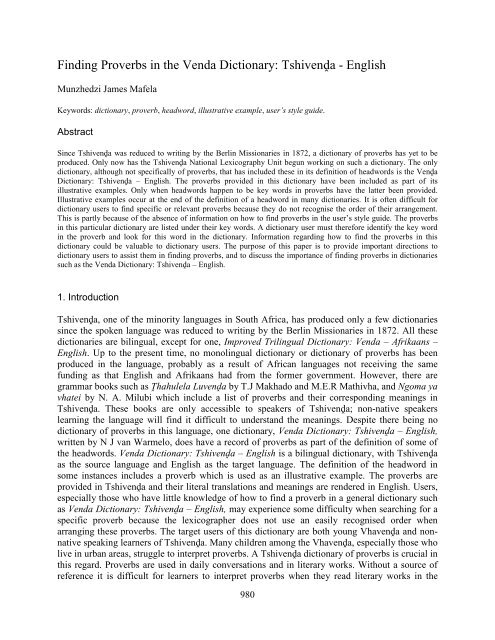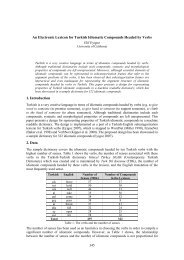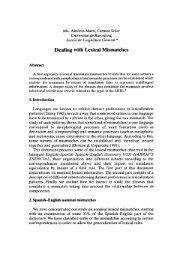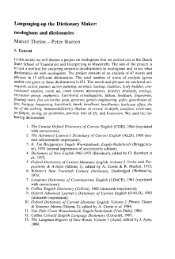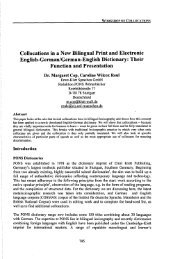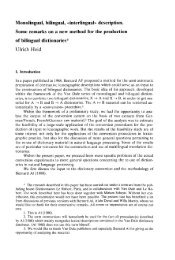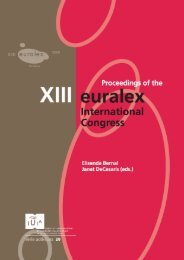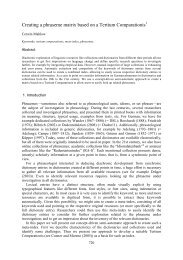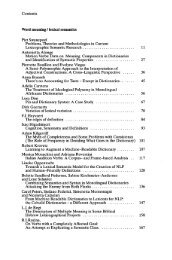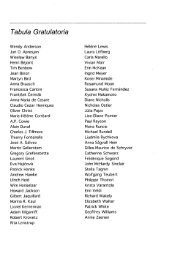Finding Proverbs in the Venda Dictionary: Tshivenḓa ... - Euralex
Finding Proverbs in the Venda Dictionary: Tshivenḓa ... - Euralex
Finding Proverbs in the Venda Dictionary: Tshivenḓa ... - Euralex
Create successful ePaper yourself
Turn your PDF publications into a flip-book with our unique Google optimized e-Paper software.
<strong>F<strong>in</strong>d<strong>in</strong>g</strong> <strong>Proverbs</strong> <strong>in</strong> <strong>the</strong> <strong>Venda</strong> <strong>Dictionary</strong>: <strong>Tshivenḓa</strong> - English<br />
Munzhedzi James Mafela<br />
Keywords: dictionary, proverb, headword, illustrative example, user’s style guide.<br />
Abstract<br />
S<strong>in</strong>ce <strong>Tshivenḓa</strong> was reduced to writ<strong>in</strong>g by <strong>the</strong> Berl<strong>in</strong> Missionaries <strong>in</strong> 1872, a dictionary of proverbs has yet to be<br />
produced. Only now has <strong>the</strong> <strong>Tshivenḓa</strong> National Lexicography Unit begun work<strong>in</strong>g on such a dictionary. The only<br />
dictionary, although not specifically of proverbs, that has <strong>in</strong>cluded <strong>the</strong>se <strong>in</strong> its def<strong>in</strong>ition of headwords is <strong>the</strong> Venḓa<br />
<strong>Dictionary</strong>: <strong>Tshivenḓa</strong> – English. The proverbs provided <strong>in</strong> this dictionary have been <strong>in</strong>cluded as part of its<br />
illustrative examples. Only when headwords happen to be key words <strong>in</strong> proverbs have <strong>the</strong> latter been provided.<br />
Illustrative examples occur at <strong>the</strong> end of <strong>the</strong> def<strong>in</strong>ition of a headword <strong>in</strong> many dictionaries. It is often difficult for<br />
dictionary users to f<strong>in</strong>d specific or relevant proverbs because <strong>the</strong>y do not recognise <strong>the</strong> order of <strong>the</strong>ir arrangement.<br />
This is partly because of <strong>the</strong> absence of <strong>in</strong>formation on how to f<strong>in</strong>d proverbs <strong>in</strong> <strong>the</strong> user’s style guide. The proverbs<br />
<strong>in</strong> this particular dictionary are listed under <strong>the</strong>ir key words. A dictionary user must <strong>the</strong>refore identify <strong>the</strong> key word<br />
<strong>in</strong> <strong>the</strong> proverb and look for this word <strong>in</strong> <strong>the</strong> dictionary. Information regard<strong>in</strong>g how to f<strong>in</strong>d <strong>the</strong> proverbs <strong>in</strong> this<br />
dictionary could be valuable to dictionary users. The purpose of this paper is to provide important directions to<br />
dictionary users to assist <strong>the</strong>m <strong>in</strong> f<strong>in</strong>d<strong>in</strong>g proverbs, and to discuss <strong>the</strong> importance of f<strong>in</strong>d<strong>in</strong>g proverbs <strong>in</strong> dictionaries<br />
such as <strong>the</strong> <strong>Venda</strong> <strong>Dictionary</strong>: <strong>Tshivenḓa</strong> – English.<br />
1. Introduction<br />
<strong>Tshivenḓa</strong>, one of <strong>the</strong> m<strong>in</strong>ority languages <strong>in</strong> South Africa, has produced only a few dictionaries<br />
s<strong>in</strong>ce <strong>the</strong> spoken language was reduced to writ<strong>in</strong>g by <strong>the</strong> Berl<strong>in</strong> Missionaries <strong>in</strong> 1872. All <strong>the</strong>se<br />
dictionaries are bil<strong>in</strong>gual, except for one, Improved Tril<strong>in</strong>gual <strong>Dictionary</strong>: <strong>Venda</strong> – Afrikaans –<br />
English. Up to <strong>the</strong> present time, no monol<strong>in</strong>gual dictionary or dictionary of proverbs has been<br />
produced <strong>in</strong> <strong>the</strong> language, probably as a result of African languages not receiv<strong>in</strong>g <strong>the</strong> same<br />
fund<strong>in</strong>g as that English and Afrikaans had from <strong>the</strong> former government. However, <strong>the</strong>re are<br />
grammar books such as Ṱhahulela Luvenḓa by T.J Makhado and M.E.R Mathivha, and Ngoma ya<br />
vhatei by N. A. Milubi which <strong>in</strong>clude a list of proverbs and <strong>the</strong>ir correspond<strong>in</strong>g mean<strong>in</strong>gs <strong>in</strong><br />
<strong>Tshivenḓa</strong>. These books are only accessible to speakers of <strong>Tshivenḓa</strong>; non-native speakers<br />
learn<strong>in</strong>g <strong>the</strong> language will f<strong>in</strong>d it difficult to understand <strong>the</strong> mean<strong>in</strong>gs. Despite <strong>the</strong>re be<strong>in</strong>g no<br />
dictionary of proverbs <strong>in</strong> this language, one dictionary, <strong>Venda</strong> <strong>Dictionary</strong>: <strong>Tshivenḓa</strong> – English,<br />
written by N J van Warmelo, does have a record of proverbs as part of <strong>the</strong> def<strong>in</strong>ition of some of<br />
<strong>the</strong> headwords. <strong>Venda</strong> <strong>Dictionary</strong>: <strong>Tshivenḓa</strong> – English is a bil<strong>in</strong>gual dictionary, with <strong>Tshivenḓa</strong><br />
as <strong>the</strong> source language and English as <strong>the</strong> target language. The def<strong>in</strong>ition of <strong>the</strong> headword <strong>in</strong><br />
some <strong>in</strong>stances <strong>in</strong>cludes a proverb which is used as an illustrative example. The proverbs are<br />
provided <strong>in</strong> <strong>Tshivenḓa</strong> and <strong>the</strong>ir literal translations and mean<strong>in</strong>gs are rendered <strong>in</strong> English. Users,<br />
especially those who have little knowledge of how to f<strong>in</strong>d a proverb <strong>in</strong> a general dictionary such<br />
as <strong>Venda</strong> <strong>Dictionary</strong>: <strong>Tshivenḓa</strong> – English, may experience some difficulty when search<strong>in</strong>g for a<br />
specific proverb because <strong>the</strong> lexicographer does not use an easily recognised order when<br />
arrang<strong>in</strong>g <strong>the</strong>se proverbs. The target users of this dictionary are both young Vhavenḓa and nonnative<br />
speak<strong>in</strong>g learners of <strong>Tshivenḓa</strong>. Many children among <strong>the</strong> Vhavenḓa, especially those who<br />
live <strong>in</strong> urban areas, struggle to <strong>in</strong>terpret proverbs. A <strong>Tshivenḓa</strong> dictionary of proverbs is crucial <strong>in</strong><br />
this regard. <strong>Proverbs</strong> are used <strong>in</strong> daily conversations and <strong>in</strong> literary works. Without a source of<br />
reference it is difficult for learners to <strong>in</strong>terpret proverbs when <strong>the</strong>y read literary works <strong>in</strong> <strong>the</strong><br />
980
language. In <strong>the</strong> absence of a dictionary of <strong>Tshivenḓa</strong> proverbs, Van Warmelo’s <strong>Venda</strong><br />
<strong>Dictionary</strong>: <strong>Tshivenḓa</strong> – English goes some way towards solv<strong>in</strong>g <strong>the</strong> problem. The same applies<br />
to non-native speakers of <strong>Tshivenḓa</strong> learn<strong>in</strong>g <strong>the</strong> language; <strong>the</strong>y f<strong>in</strong>d it difficult to <strong>in</strong>terpret<br />
<strong>Tshivenḓa</strong> proverbs without a source of reference. For <strong>the</strong>se learners to communicate effectively<br />
<strong>in</strong> <strong>the</strong> community of language speakers, <strong>the</strong>y need sources to refer to <strong>in</strong> order to <strong>in</strong>fer <strong>the</strong><br />
mean<strong>in</strong>gs of proverbs. This dictionary is useful because <strong>the</strong> literal translation of <strong>the</strong> proverb and<br />
its mean<strong>in</strong>g are provided <strong>in</strong> English, <strong>the</strong> language most of <strong>the</strong>se learners will understand.<br />
<strong>Proverbs</strong> <strong>in</strong> <strong>the</strong> <strong>Venda</strong> <strong>Dictionary</strong>: <strong>Tshivenḓa</strong> – English have been spread throughout <strong>the</strong><br />
entire dictionary. A dictionary user, look<strong>in</strong>g for a specific proverb <strong>in</strong> this dictionary, would have<br />
trouble know<strong>in</strong>g where to start. This is partly because of <strong>the</strong> absence of <strong>in</strong>formation on how to<br />
f<strong>in</strong>d proverbs <strong>in</strong> <strong>the</strong> user’s style guide. Had such <strong>in</strong>formation been <strong>in</strong>cluded, it would have made<br />
look<strong>in</strong>g for proverbs a simple task. The purpose of this paper is to provide some useful h<strong>in</strong>ts<br />
which could help dictionary users to f<strong>in</strong>d proverbs without difficulty, and to discuss <strong>the</strong><br />
importance of f<strong>in</strong>d<strong>in</strong>g proverbs <strong>in</strong> <strong>the</strong> <strong>Venda</strong> <strong>Dictionary</strong>: <strong>Tshivenḓa</strong> – English.<br />
The discussion below will commence with a sketch of <strong>the</strong> <strong>the</strong>oretical framework of <strong>the</strong><br />
study, followed by <strong>the</strong> method of order<strong>in</strong>g proverbs <strong>in</strong> <strong>the</strong> <strong>Venda</strong> <strong>Dictionary</strong>: <strong>Tshivenḓa</strong> –<br />
English. The study will also reflect on <strong>the</strong> importance of f<strong>in</strong>d<strong>in</strong>g proverbs <strong>in</strong> this dictionary.<br />
2. Theoretical Framework<br />
A dictionary is a source that lists words <strong>in</strong> alphabetical order and provides <strong>the</strong>ir mean<strong>in</strong>gs. Many<br />
scholars provide similar def<strong>in</strong>itions of <strong>the</strong> concept “dictionary”. The general argument is that a<br />
dictionary provides <strong>the</strong> mean<strong>in</strong>gs of words. Underhill (1980:32) argues: “Giv<strong>in</strong>g <strong>the</strong> mean<strong>in</strong>gs of<br />
words is often thought to be <strong>the</strong> ma<strong>in</strong> purpose of a dictionary. But, as we have seen, <strong>the</strong><br />
dictionary also conta<strong>in</strong>s o<strong>the</strong>r areas of <strong>in</strong>formation useful to <strong>the</strong> student.” Landau (1984:5)<br />
def<strong>in</strong>es <strong>the</strong> concept “dictionary” as “... a book that lists words <strong>in</strong> alphabetical order and describes<br />
<strong>the</strong>ir mean<strong>in</strong>gs. Modern dictionaries often <strong>in</strong>clude <strong>in</strong>formation about spell<strong>in</strong>g, syllabication,<br />
pronunciation, synonyms, and grammar, and sometimes illustrations as well.” The above<br />
def<strong>in</strong>itions are summed up by Hartmann (1984:1) when he writes that a dictionary is a reference<br />
book conta<strong>in</strong><strong>in</strong>g words of a language or language variety, usually alphabetically arranged, with<br />
<strong>in</strong>formation on <strong>the</strong> forms, pronunciation, functions, mean<strong>in</strong>gs and idiomatic uses. Hartmann’s<br />
emphasis is on <strong>the</strong> arrangement of words <strong>in</strong> <strong>the</strong> reference book. Jackson (2002:22) concurs with<br />
Hartmann (1984), say<strong>in</strong>g that dictionaries are reference books which people consult to f<strong>in</strong>d<br />
<strong>in</strong>formation about words. A good dictionary will <strong>in</strong>clude alphabetically arranged words, with<br />
<strong>in</strong>formation on <strong>the</strong> forms, pronunciation, syllabication, grammar, functions, mean<strong>in</strong>gs and<br />
examples. Dictionaries that <strong>in</strong>clude illustrative examples are popular among users because <strong>the</strong>se<br />
illustrations contribute to <strong>the</strong>ir understand<strong>in</strong>g by demonstrat<strong>in</strong>g <strong>the</strong> use of a word <strong>in</strong> its context. In<br />
<strong>the</strong> <strong>Venda</strong> <strong>Dictionary</strong>: <strong>Tshivenḓa</strong> – English, proverbs have been <strong>in</strong>cluded as part of such<br />
illustrative examples.<br />
<strong>Proverbs</strong> are a comb<strong>in</strong>ation of words to create a particular mean<strong>in</strong>g. This mean<strong>in</strong>g can<br />
seldom be guessed from one’s knowledge of <strong>the</strong> <strong>in</strong>dividual words mak<strong>in</strong>g up <strong>the</strong> proverb<br />
(Underhill 1980:39). Accord<strong>in</strong>g to Dalfovo (1997:42), “<strong>Proverbs</strong> may be described as say<strong>in</strong>gs<br />
orig<strong>in</strong>at<strong>in</strong>g from experience, be<strong>in</strong>g expressed <strong>in</strong> a pithy, fixed and metaphorical language and<br />
convey<strong>in</strong>g a message”. The mean<strong>in</strong>g developed <strong>in</strong> a proverb differs from <strong>the</strong> literal mean<strong>in</strong>g of<br />
<strong>the</strong> words used. Learners of <strong>Tshivenḓa</strong>, and non-native speakers learn<strong>in</strong>g <strong>Tshivenḓa</strong> <strong>in</strong> particular,<br />
may f<strong>in</strong>d it difficult to <strong>in</strong>terpret proverbs if <strong>the</strong>se are not expla<strong>in</strong>ed to <strong>the</strong>m. Although proverbs<br />
981
lack <strong>in</strong> transparency, <strong>the</strong>y express reality and thus reflect reality <strong>in</strong> communities <strong>in</strong> which <strong>the</strong>y are<br />
spoken and are important <strong>in</strong> document<strong>in</strong>g archaic words, i.e. words that are no longer <strong>in</strong> regular<br />
use but which may occur occasionally <strong>in</strong> particular contexts. Zgusta (1971:153) notes that <strong>the</strong><br />
important th<strong>in</strong>g <strong>in</strong> this connection is that apart from o<strong>the</strong>r formal characteristics, we frequently<br />
f<strong>in</strong>d that proverbs have as <strong>the</strong>ir constituent parts obsolete words and expressions which are not<br />
used elsewhere. <strong>Proverbs</strong> also make a comment on <strong>the</strong> culture of <strong>the</strong> language community. A<br />
dictionary of proverbs is thus very important <strong>in</strong> understand<strong>in</strong>g a language.<br />
<strong>Proverbs</strong> are an important aspect of communication <strong>in</strong> African societies. They are used <strong>in</strong><br />
everyday conversations. Regard<strong>in</strong>g this importance of proverbs, Mkunchu (1997:107) writes:<br />
<strong>Proverbs</strong> can be used <strong>in</strong> formal or <strong>in</strong>formal sett<strong>in</strong>gs. Informal situations may be ord<strong>in</strong>ary<br />
day-to-day conversations to advise, rebuke and <strong>in</strong>struct. <strong>Proverbs</strong> can also be used <strong>in</strong><br />
formal ga<strong>the</strong>r<strong>in</strong>gs or special occasions. Such ga<strong>the</strong>r<strong>in</strong>gs can be a ceremony to mark <strong>the</strong><br />
end of a period of mourn<strong>in</strong>g, a meet<strong>in</strong>g called to smooth over a disagreement/conflict, or<br />
<strong>the</strong> payment of dowry and <strong>in</strong>itiation rites.<br />
In this regard, Saayman (1997: ix) says: “Certa<strong>in</strong>ly, any social scientist who has done research<br />
among African peoples will testify to <strong>the</strong> enormous importance of African proverbs <strong>in</strong> African<br />
culture and society”. Accord<strong>in</strong>g to this author, this is one aspect which <strong>the</strong> processes of<br />
urbanisation, <strong>in</strong>dustrialisation and westernisation have not been able to sweep away. It is<br />
<strong>the</strong>refore important to have a dictionary of proverbs <strong>in</strong> <strong>the</strong> African languages or at least to <strong>in</strong>clude<br />
proverbs <strong>in</strong> general dictionaries because <strong>the</strong>y are used <strong>in</strong> everyday conversations <strong>in</strong> African<br />
societies. In this regard, Lusimba (2002:1) says: “They will <strong>the</strong>refore have to form part of <strong>the</strong><br />
composition of dictionaries. In fact, for lexicography as discipl<strong>in</strong>e of l<strong>in</strong>guistic science, <strong>the</strong><br />
treatment of proverbs and idioms is of card<strong>in</strong>al importance because <strong>the</strong>y are <strong>the</strong> bearers of <strong>the</strong><br />
culture and customs of a people.” The <strong>Venda</strong> <strong>Dictionary</strong>: <strong>Tshivenḓa</strong> – English is very valuable <strong>in</strong><br />
this regard because it helps learners to communicate effectively <strong>in</strong> <strong>Tshivenḓa</strong> and to experience<br />
<strong>the</strong> culture of <strong>the</strong> Vhavenḓa <strong>in</strong> this regard.<br />
3. The nature of order<strong>in</strong>g proverbs <strong>in</strong> <strong>the</strong> <strong>Venda</strong> <strong>Dictionary</strong>: <strong>Tshivenḓa</strong> – English<br />
As <strong>in</strong>dicated above, <strong>the</strong> proverbs <strong>in</strong>cluded <strong>in</strong> <strong>the</strong> <strong>Venda</strong> <strong>Dictionary</strong>: <strong>Tshivenḓa</strong> – English have<br />
been spread throughout <strong>the</strong> dictionary. At first glance one might th<strong>in</strong>k that <strong>the</strong>re was no order to<br />
<strong>the</strong> arrangement of <strong>the</strong> proverbs <strong>in</strong>cluded <strong>in</strong> this dictionary, but <strong>in</strong> fact <strong>the</strong>re is a logical<br />
arrangement; <strong>the</strong> problem is, though, that no <strong>in</strong>formation was <strong>in</strong>cluded <strong>in</strong> <strong>the</strong> style guide for users<br />
regard<strong>in</strong>g how to f<strong>in</strong>d <strong>the</strong>se proverbs. Without this <strong>in</strong>formation <strong>in</strong> <strong>the</strong> style guide, some<br />
dictionary users might overlook <strong>the</strong> proverbs, conclud<strong>in</strong>g that <strong>Tshivenḓa</strong> does not have a<br />
dictionary which <strong>in</strong>cludes proverbs. However, what users can identify at a glance when brows<strong>in</strong>g<br />
through <strong>the</strong> dictionary is Prov: which has been used as an abbreviation of <strong>the</strong> word proverb, and<br />
this <strong>in</strong>dicates <strong>the</strong> presence of an explanation of a proverb. In fact, Van Warmelo uses not only<br />
proverbs as illustrative examples of <strong>the</strong> def<strong>in</strong>ition of <strong>the</strong> headword; he also makes use of idioms<br />
and riddles for <strong>the</strong> same purpose. Idioms can be identified through <strong>the</strong> use of <strong>the</strong> abbreviation<br />
Phr: whereas <strong>the</strong> riddles are identified by Thai:.<br />
The lexicographer has recorded as many proverbs as he could <strong>in</strong> this dictionary. The<br />
number of proverbs used as illustrative examples exceeds that of idioms and riddles. As <strong>in</strong>dicated<br />
above, proverbs <strong>in</strong> <strong>Venda</strong> <strong>Dictionary</strong>: <strong>Tshivenḓa</strong> – English have been <strong>in</strong>cluded as part of <strong>the</strong><br />
982
def<strong>in</strong>ition of <strong>the</strong> headword. In all cases, <strong>the</strong> proverbs provided serve as illustrative examples to<br />
show <strong>the</strong> use of <strong>the</strong> headword <strong>in</strong> context. Illustrative examples are helpful <strong>in</strong> clarify<strong>in</strong>g mean<strong>in</strong>g<br />
discrim<strong>in</strong>at<strong>in</strong>g among senses, understand<strong>in</strong>g usage or connotation, and for supply<strong>in</strong>g added<br />
<strong>in</strong>formation (Hartmann 1984:1). The proverb is identified by <strong>the</strong> use of Prov: followed by <strong>the</strong><br />
proverb <strong>in</strong> <strong>Tshivenḓa</strong>, and <strong>the</strong>n <strong>the</strong> literal English translation and <strong>the</strong> mean<strong>in</strong>g <strong>the</strong>reof as shown<br />
hereunder:<br />
-anetshela (applic. of –anea) narrate, recount, relate<br />
Prov. U anetshelwa ndi u dzimiwa “To be told is to be st<strong>in</strong>ted”. A report always<br />
leaves someth<strong>in</strong>g out; better go and f<strong>in</strong>d out yourself (Van Warmelo 1989:3).<br />
The headword <strong>in</strong> this regard is –anetshela, which is followed by its English equivalents. The<br />
proverb that follows serves as an illustrative example. A dictionary user better understands <strong>the</strong><br />
mean<strong>in</strong>g of <strong>the</strong> headword –anetshela when it is used <strong>in</strong> context <strong>in</strong> <strong>the</strong> proverb.<br />
Lexicographers can order idioms and proverbs <strong>in</strong> different ways <strong>in</strong> <strong>the</strong>ir dictionaries.<br />
Humble (2001:105) states: “In traditional dictionaries, idioms can be classified ei<strong>the</strong>r under <strong>the</strong>ir<br />
first word; under <strong>the</strong> word which is considered most important; or accord<strong>in</strong>g to <strong>the</strong> semantic<br />
field. Not all of <strong>the</strong>se orders can be used at <strong>the</strong> same time. The traditional dictionaries often have<br />
<strong>the</strong> right <strong>in</strong>formation but <strong>the</strong>y have limited ways of mak<strong>in</strong>g it accessible.” Regular users of<br />
dictionaries are aware of this classification, but many learners are not familiar with it and <strong>the</strong>y<br />
need to be <strong>in</strong>formed <strong>in</strong> <strong>the</strong> style guide. <strong>Proverbs</strong> <strong>in</strong> <strong>the</strong> <strong>Venda</strong> <strong>Dictionary</strong>: <strong>Tshivenḓa</strong> – English<br />
can be accessed by identify<strong>in</strong>g a key word <strong>in</strong> <strong>the</strong> proverb which, accord<strong>in</strong>g to Humble (2001), is<br />
considered most important, and by look<strong>in</strong>g for it as headword <strong>in</strong> <strong>the</strong> dictionary. The order<strong>in</strong>g of<br />
headwords <strong>in</strong> this regard is accord<strong>in</strong>g to <strong>the</strong> letters of <strong>the</strong> alphabet. Underhill (1980:39) makes<br />
this comment about f<strong>in</strong>d<strong>in</strong>g an idiomatic expression <strong>in</strong> a dictionary:<br />
To do this you must first decide which word <strong>in</strong> <strong>the</strong> expression is <strong>the</strong> key word. The key<br />
word is usually <strong>the</strong> ma<strong>in</strong> word <strong>in</strong> <strong>the</strong> expression, and is <strong>the</strong> headword <strong>in</strong> <strong>the</strong> dictionary<br />
under which <strong>the</strong> idiomatic expression will be found. If you do not f<strong>in</strong>d <strong>the</strong> idiomatic<br />
expression <strong>the</strong> first time, <strong>the</strong>n try ano<strong>the</strong>r key word.<br />
The above explanation also applies to f<strong>in</strong>d<strong>in</strong>g a proverb <strong>in</strong> a dictionary. One may end up try<strong>in</strong>g<br />
more than one key word <strong>in</strong> order to f<strong>in</strong>d <strong>the</strong> exact proverb for which one is look<strong>in</strong>g, but <strong>in</strong> <strong>the</strong><br />
end, one will be <strong>in</strong> <strong>the</strong> position to f<strong>in</strong>d <strong>the</strong> proverb. When a dictionary user tries to search for a<br />
proverb, for example Musadzi wa muluki u hwala nga tshiteto, he or she will first identify <strong>the</strong> key<br />
words <strong>in</strong> <strong>the</strong> proverb, which are musadzi, muluki, -hwala, and tshiteto. The dictionary user will<br />
first try to f<strong>in</strong>d <strong>the</strong> proverb through <strong>the</strong> headword musadzi. In <strong>the</strong> def<strong>in</strong>ition of <strong>the</strong> headword<br />
musadzi no proverb has been provided as an illustrative example. The dictionary user will have to<br />
try <strong>the</strong> second key word, which is muluki. In <strong>the</strong> def<strong>in</strong>ition of this headword, <strong>the</strong> proverb<br />
mentioned above has been used as an illustrative example. There is no need to cont<strong>in</strong>ue search<strong>in</strong>g<br />
for <strong>the</strong> proverb through <strong>the</strong> rema<strong>in</strong><strong>in</strong>g key words because <strong>the</strong> dictionary user has found it. The<br />
proverb <strong>in</strong> this regard is <strong>in</strong>troduced as follows:<br />
muluki 1 (cf. –luka) one who plaits, basket-maker.<br />
983
Prov: Musadzi wa muluki u hwala nga tshiteto “The basket-maker’s wife has to<br />
carry her th<strong>in</strong>gs <strong>in</strong> a worn-out w<strong>in</strong>now”. The tailor’s wife goes <strong>in</strong> rags (Van<br />
Warmelo 1989:225).<br />
In <strong>Venda</strong> <strong>Dictionary</strong>: <strong>Tshivenḓa</strong> – English, both <strong>the</strong> verb stems and nouns are used as key words.<br />
Hereunder follow some examples:<br />
-ṱahula weed (with <strong>the</strong> hoe)<br />
Prov: Dza musanda dzi ṱahula tshene “Royal cattle (don’t damage crops, <strong>the</strong>y<br />
merely) pull up weeds”. Children & o<strong>the</strong>rs from <strong>the</strong> chief’s place can do no wrong<br />
(Van Warmelo 1989:349).<br />
tsevhi 9 (cf. –sevha) one who warns ano<strong>the</strong>r of impend<strong>in</strong>g danger, who gives a tip or h<strong>in</strong>t<br />
Prov: A hu na muthu a faho a si na tsevhi “Nobody dies without hav<strong>in</strong>g been<br />
warned by someone”. One always gets a h<strong>in</strong>t of impend<strong>in</strong>g trouble. The difficulty<br />
lies <strong>in</strong> act<strong>in</strong>g on it (Van Warmelo 1989:387).<br />
The word -ṱahula is a verb stem, whereas tsevhi is a noun. The two words are considered to be<br />
key words <strong>in</strong> <strong>the</strong> two proverbs.<br />
A proverb can appear under two separate key words, a noun and a verb stem; under two<br />
separate nouns; and more than one proverb may occur under one key word <strong>in</strong> <strong>Venda</strong> <strong>Dictionary</strong>:<br />
<strong>Tshivenḓa</strong> – English.<br />
3.1. A proverb appears under two separate key words (noun and verb stem)<br />
In order for a dictionary user to more easily f<strong>in</strong>d <strong>the</strong> proverbs, <strong>the</strong> lexicographer uses both <strong>the</strong><br />
verb stem and <strong>the</strong> noun as headwords to identify <strong>the</strong>m <strong>in</strong> <strong>the</strong> <strong>Venda</strong> <strong>Dictionary</strong>: <strong>Tshivenḓa</strong> –<br />
English. This means that ei<strong>the</strong>r verb stems or <strong>the</strong> nouns <strong>in</strong> <strong>the</strong> proverb can be identified and used<br />
as key words. If a dictionary user fails to f<strong>in</strong>d a proverb under <strong>the</strong> verb stem identified as <strong>the</strong> key<br />
word, he or she can look for it under <strong>the</strong> noun identified as <strong>the</strong> key word. Van Warmelo (1989)<br />
has used this arrangement <strong>in</strong> his dictionary to make sure that dictionary users end up f<strong>in</strong>d<strong>in</strong>g <strong>the</strong><br />
proverb. The follow<strong>in</strong>g proverb can be located through <strong>the</strong> use of both <strong>the</strong> verb stem and <strong>the</strong><br />
noun as headwords: Hu ambuwa vhuṅanga; vhukololo a vhu ambuwi.<br />
-ambuwa ford, wade through<br />
Prov: Hu ambuwa vhuṅanga; vhukololo a vhu ambuwi “The medic<strong>in</strong>e-man who<br />
crosses a river [<strong>in</strong>to foreign territory] takes his craft with him, but royal rank<br />
cannot be taken abroad.” Away from home high birth does not count (Van<br />
Warmelo 1989:2)<br />
vhukololo 14 noble birth, rank or circumstance of be<strong>in</strong>g a mukololo<br />
984
Prov: Hu ambuwa vhuṅanga; vhukololo a vhu ambuwi “Professional status crosses<br />
rivers but royal descent does not,” i.e. a doctor is still a doctor <strong>in</strong> a strange country<br />
but a pr<strong>in</strong>ce who crosses <strong>the</strong> frontier becomes a nobody (Van Warmelo 1989:463)<br />
The two words, <strong>the</strong> verb stem –ambuwa and <strong>the</strong> noun vhukololo are both found <strong>in</strong> <strong>the</strong> proverb Hu<br />
ambuwa vhuṅanga; vhukololo a vhu ambuwi. A dictionary user could consider ambuwa as <strong>the</strong><br />
keyword <strong>in</strong> <strong>the</strong> proverb and locate it by search<strong>in</strong>g for it as headword; at <strong>the</strong> same time, if he or<br />
she considers vhukololo to be <strong>the</strong> key word, <strong>the</strong> same proverb could be located by search<strong>in</strong>g for<br />
<strong>the</strong> noun vhukololo as <strong>the</strong> headword. Identify<strong>in</strong>g <strong>the</strong>se two words as key words <strong>in</strong> <strong>the</strong> proverb can<br />
help dictionary users to f<strong>in</strong>d <strong>the</strong> proverb.<br />
3.2. A proverb appears under two separate nouns<br />
In certa<strong>in</strong> <strong>in</strong>stances, <strong>the</strong> same proverb can appear under entries for two separate nouns.<br />
Identify<strong>in</strong>g <strong>the</strong> two nouns <strong>in</strong> <strong>the</strong> proverb as key words will help dictionary users to f<strong>in</strong>d <strong>the</strong><br />
proverb. The proverb Muts<strong>in</strong>da ndi khw<strong>in</strong>e, shaka ndi bulayo is one example which illustrates<br />
this.<br />
bulayo 5 (cf. –vhulaha, -vhulaya) massacre, murder; a great kill<strong>in</strong>g, heavy mortality, as <strong>in</strong><br />
epidemic of stock or people<br />
Prov: Muts<strong>in</strong>da ndi khw<strong>in</strong>e, shaka ndi bulayo “A non-relative is better; a relative<br />
is murder”. Relations cause more trouble than o<strong>the</strong>r people (Van Warmelo<br />
1989:16)<br />
muts<strong>in</strong>da 1 non-relative, person not belong<strong>in</strong>g to one’s patril<strong>in</strong>eal k<strong>in</strong>ship group, i.e.<br />
anyone who, not be<strong>in</strong>g descended from a common, known patril<strong>in</strong>eal ancestor, may not<br />
take part <strong>in</strong> <strong>the</strong> family ancestor-cult.<br />
Prov: Muts<strong>in</strong>da ndi khw<strong>in</strong>e, shaka ndi bulayo “A stranger is better than a relative;<br />
a k<strong>in</strong>sman may be <strong>the</strong> death of one” (Van Warmelo 1989:250)<br />
Both bulayo and muts<strong>in</strong>da are nouns found <strong>in</strong> one proverb and could be identified as key words<br />
to help f<strong>in</strong>d <strong>the</strong> proverb <strong>in</strong> <strong>the</strong> dictionary. In this <strong>in</strong>stance, Van Warmelo uses both nouns to<br />
search for <strong>the</strong> same proverb.<br />
3.3. More than one proverb appears under one headword<br />
Van Warmelo not only provides one proverb under one headword; at times he lists a number of<br />
proverbs under one headword as illustrative examples. This is always done if <strong>the</strong> headword can<br />
be used <strong>in</strong> different contexts. In some <strong>in</strong>stances he lists up to four proverbs as illustrative<br />
examples for one headword. The follow<strong>in</strong>g is an example of three proverbs listed as illustrative<br />
examples under one headword, -fhalala:<br />
-fhalala (<strong>in</strong>tr.) 1 spill, overflow, disperse. 2 (= -phalala) rush out to rescue (of a lot of<br />
people). 3 die away from home<br />
985
Prov: Mukange a fa, vhana vha Mukange vha a fhalala “When Mr Gu<strong>in</strong>ea Fowl<br />
dies, his chicks scatter”, i.e. when a great man dies, his children and dependents<br />
disperse and <strong>the</strong> household is broken up<br />
Prov: Thakha ndi mulambo, a i lengi u fhalala “Wealth (property) is like a river<br />
(<strong>in</strong> flood), it goes down quickly”<br />
Prov: Zwivhuya a zwi ḓali, zwa ḓala zwi a fhalala “Good th<strong>in</strong>gs are not common,<br />
and when <strong>the</strong>y do appear <strong>the</strong>y soon vanish aga<strong>in</strong>”<br />
The key word <strong>in</strong> <strong>the</strong> proverbs provided above is <strong>the</strong> verb stem –fhalala, which <strong>in</strong> this case is <strong>the</strong><br />
headword. This verb stem has different mean<strong>in</strong>gs depend<strong>in</strong>g on <strong>the</strong> context. As a result a number<br />
of proverbs are provided as illustrative examples, depend<strong>in</strong>g on <strong>the</strong> sense <strong>in</strong> which <strong>the</strong> word is<br />
used. So, dictionary users must check all <strong>the</strong> proverbs listed under <strong>the</strong> headword <strong>in</strong> order to f<strong>in</strong>d<br />
<strong>the</strong> sense for which <strong>the</strong>y are look<strong>in</strong>g.<br />
<strong>Proverbs</strong> listed <strong>in</strong> this dictionary are very helpful to dictionary users, especially learners<br />
and non-native speakers learn<strong>in</strong>g <strong>Tshivenḓa</strong>. Instead of just provid<strong>in</strong>g <strong>the</strong> mean<strong>in</strong>gs of <strong>the</strong><br />
proverbs, <strong>the</strong> dictionary also provides <strong>the</strong>ir literal translation which helps <strong>in</strong> <strong>the</strong> learn<strong>in</strong>g of<br />
mean<strong>in</strong>gs of o<strong>the</strong>r words <strong>in</strong> <strong>the</strong> proverb. Under <strong>the</strong> next sub-head<strong>in</strong>g <strong>the</strong> discussion will focus on<br />
<strong>the</strong> importance of f<strong>in</strong>d<strong>in</strong>g a proverb <strong>in</strong> <strong>the</strong> <strong>Venda</strong> <strong>Dictionary</strong>: <strong>Tshivenḓa</strong> – English.<br />
4. The importance of f<strong>in</strong>d<strong>in</strong>g a proverb <strong>in</strong> <strong>the</strong> <strong>Venda</strong> <strong>Dictionary</strong>: <strong>Tshivenḓa</strong> – English<br />
<strong>Dictionary</strong> users learn a great deal from <strong>the</strong> <strong>in</strong>formation provided <strong>in</strong> proverbs <strong>in</strong> <strong>the</strong> <strong>Venda</strong><br />
<strong>Dictionary</strong>: <strong>Tshivenḓa</strong> - English. Besides enrich<strong>in</strong>g <strong>the</strong>ir understand<strong>in</strong>g of <strong>the</strong> word <strong>the</strong>y also get<br />
to know o<strong>the</strong>r aspects of <strong>the</strong> headword through <strong>the</strong> <strong>in</strong>clusion of <strong>the</strong> proverb as an illustrative<br />
example. Through proverbs, dictionary users get to know <strong>the</strong> existence of archaic words <strong>in</strong> <strong>the</strong><br />
language, and <strong>the</strong> accompany<strong>in</strong>g mean<strong>in</strong>gs/equivalents of o<strong>the</strong>r key words <strong>in</strong> <strong>the</strong> proverb.<br />
Fur<strong>the</strong>rmore, proverbs <strong>in</strong>form dictionary users about <strong>the</strong> culture of <strong>the</strong> society <strong>in</strong> which <strong>the</strong>y are<br />
found. Van Warmelo’s use of proverbs as illustrative examples helps to enrich <strong>the</strong> <strong>Tshivenḓa</strong><br />
vocabulary of dictionary users as well as <strong>the</strong>ir knowledge of <strong>the</strong> culture of <strong>the</strong> Vhavenḓa.<br />
4.1. <strong>F<strong>in</strong>d<strong>in</strong>g</strong> proverbs enriches <strong>the</strong> vocabulary of dictionary users<br />
The def<strong>in</strong>ition of a headword <strong>in</strong> a bil<strong>in</strong>gual dictionary entails <strong>the</strong> provision of <strong>the</strong> equivalent word<br />
<strong>in</strong> <strong>the</strong> target language. In his def<strong>in</strong>ition of <strong>the</strong> headwords <strong>in</strong> <strong>the</strong> <strong>Venda</strong> <strong>Dictionary</strong>: <strong>Tshivenḓa</strong> –<br />
English, Van Warmelo provides <strong>the</strong> English equivalents which help a non-native speaker of<br />
<strong>Tshivenḓa</strong> to understand <strong>the</strong> mean<strong>in</strong>g of <strong>the</strong> headword. As <strong>in</strong>dicated above, <strong>the</strong> lexicographer<br />
also provides a proverb to serve as an illustrative example. The mean<strong>in</strong>g of <strong>the</strong> headword<br />
becomes clearer when <strong>the</strong> word is used <strong>in</strong> context. The proverb is made up of many words; some<br />
of <strong>the</strong>m cannot be found <strong>in</strong>dividually as headwords <strong>in</strong> <strong>the</strong> dictionary. After provid<strong>in</strong>g <strong>the</strong> proverb<br />
as an illustrative example, <strong>the</strong> lexicographer provides <strong>the</strong> literal mean<strong>in</strong>g of <strong>the</strong> proverb. In <strong>the</strong><br />
literal translation of <strong>the</strong> proverb English equivalents of <strong>the</strong> words <strong>in</strong> <strong>the</strong> proverb are provided.<br />
<strong>Dictionary</strong> users get to know <strong>the</strong> mean<strong>in</strong>g of o<strong>the</strong>r words of <strong>the</strong> proverb without search<strong>in</strong>g for<br />
986
<strong>the</strong>m <strong>in</strong> <strong>the</strong> dictionary; <strong>the</strong>reby <strong>in</strong>creas<strong>in</strong>g <strong>the</strong>ir <strong>Tshivenḓa</strong> vocabulary. This is illustrated by <strong>the</strong><br />
def<strong>in</strong>ition of <strong>the</strong> headword bulayo below:<br />
bulayo 5 (cf. –vhulaha, vhulaya) massacre, murder, a great kill<strong>in</strong>g, heavy mortality, as <strong>in</strong><br />
epidemic of stock or people<br />
Prov: Muts<strong>in</strong>da ndi khw<strong>in</strong>e, shaka ndi bulayo “A non-relative is better; a relative<br />
is murder”. Relations cause more trouble than o<strong>the</strong>r people (Van Warmelo<br />
1989:16).<br />
The headword which needs some def<strong>in</strong>ition is bulayo. The lexicographer has def<strong>in</strong>ed it, and has<br />
provided a proverb as an illustrative example. In <strong>the</strong> proverb <strong>the</strong>re are o<strong>the</strong>r key words which a<br />
dictionary user may like to search for <strong>the</strong>ir equivalents. Words such as muts<strong>in</strong>da, khw<strong>in</strong>e and<br />
shaka, toge<strong>the</strong>r with bulayo, are key words <strong>in</strong> <strong>the</strong> proverb. By provid<strong>in</strong>g <strong>the</strong> literal mean<strong>in</strong>g of <strong>the</strong><br />
proverb Muts<strong>in</strong>da ndi khw<strong>in</strong>e, shaka ndi bulayo, a dictionary user can identify <strong>the</strong> equivalents of<br />
muts<strong>in</strong>da, khw<strong>in</strong>e and shaka by association, which are non-relative, better and relative<br />
respectively. The dictionary user’s vocabulary is enriched without go<strong>in</strong>g to <strong>the</strong> trouble of<br />
search<strong>in</strong>g for <strong>the</strong> equivalents of <strong>the</strong>se o<strong>the</strong>r words <strong>in</strong> <strong>the</strong> dictionary.<br />
4.2. <strong>F<strong>in</strong>d<strong>in</strong>g</strong> proverbs <strong>in</strong>troduces dictionary users to archaic traditions<br />
<strong>Proverbs</strong> have been used s<strong>in</strong>ce time immemorial <strong>in</strong> <strong>the</strong> life of Africans. They have been and<br />
rema<strong>in</strong> a most powerful and effective <strong>in</strong>strument for <strong>the</strong> transmission of culture. F<strong>in</strong>negan (1970)<br />
states that <strong>the</strong> use of proverbs is a social mode of communication which has a dom<strong>in</strong>ant role <strong>in</strong><br />
most African societies. With <strong>the</strong> development of languages and <strong>the</strong> modernisation of life <strong>in</strong><br />
general, some words become archaic because <strong>the</strong>y cease to be used regularly. Mafela (1996)<br />
def<strong>in</strong>es archaic words as words that have become outdated. Few people <strong>in</strong> <strong>the</strong> society use <strong>the</strong>m<br />
for conversation purposes, besides <strong>the</strong> aged. However, <strong>the</strong>ir use <strong>in</strong> proverbs does not change. As<br />
a result, young learners and non-native speakers of <strong>Tshivenḓa</strong> need to know <strong>the</strong> mean<strong>in</strong>g of<br />
archaic words because <strong>the</strong>y are frequent <strong>in</strong> proverbs which are used on a daily basis. Children<br />
grow<strong>in</strong>g up <strong>in</strong> urban areas have little grasp of <strong>the</strong> mean<strong>in</strong>g of proverbs because of <strong>the</strong> presence of<br />
archaic words. <strong>Proverbs</strong> with archaic words are fur<strong>the</strong>r used <strong>in</strong> creative works such as prose and<br />
drama. The only place where young learners of <strong>Tshivenḓa</strong> and non-native speakers of <strong>Tshivenḓa</strong><br />
can f<strong>in</strong>d <strong>the</strong> mean<strong>in</strong>gs of <strong>the</strong>se proverbs and archaic words is <strong>Venda</strong> <strong>Dictionary</strong>: <strong>Tshivenḓa</strong><br />
English. By mak<strong>in</strong>g use of proverbs as illustrative examples <strong>in</strong> his dictionary, Van Warmelo has<br />
made it simple for such people to acquire <strong>the</strong> mean<strong>in</strong>gs of archaic words. In <strong>the</strong> example below,<br />
dictionary users discover <strong>the</strong> existence of an archaic word of which <strong>the</strong>y may not have been<br />
aware.<br />
ḓumbu 5 1 storm, gale. 2 Hunt<strong>in</strong>g Wasp (Hemipepsisv<strong>in</strong>dex Smith), from its buzz<strong>in</strong>g<br />
Prov: Ḓuvha ḽa maḓumbu dzi lala na mavhoḓa adzo “When <strong>the</strong>re are storms <strong>the</strong><br />
cows are allowed to have <strong>the</strong>ir calves with <strong>the</strong>m for <strong>the</strong> night”. Circumstances<br />
alter cases. Necessity knows no law (Van Warmelo 1989:23).<br />
987
Ḓumbu is <strong>the</strong> headword which is followed by <strong>the</strong> English equivalents. <strong>Dictionary</strong> users discover<br />
<strong>the</strong> mean<strong>in</strong>g of <strong>the</strong> headword through <strong>the</strong> provision of <strong>the</strong>se equivalents. However, when <strong>the</strong><br />
headword ḓumbu is used <strong>in</strong> context, by us<strong>in</strong>g a proverb as an illustrative example, <strong>the</strong> dictionary<br />
user understands <strong>the</strong> mean<strong>in</strong>g of o<strong>the</strong>r key words, <strong>in</strong>clud<strong>in</strong>g mavhoḓa. Mavhoḓa is an archaic<br />
word and its use <strong>in</strong> <strong>the</strong> language community is fad<strong>in</strong>g. From <strong>the</strong> literal translation of <strong>the</strong> proverb<br />
one realises that mavhoḓa refers to calves. In daily conversation <strong>in</strong> present day <strong>Tshivenḓa</strong>, calves<br />
are referred to as namana. The provision of <strong>the</strong> literal translation of <strong>the</strong> proverb thus assists <strong>in</strong><br />
illum<strong>in</strong>at<strong>in</strong>g <strong>the</strong> mean<strong>in</strong>gs of <strong>the</strong> o<strong>the</strong>r words, such as mavhoḓa. When <strong>the</strong> proverb Ḓuvha ḽa<br />
maḓumbu dzi lala na mavhoḓa adzo is used <strong>in</strong> daily conversation, dictionary users are able to<br />
follow <strong>the</strong> conversation because <strong>the</strong>y know <strong>the</strong> mean<strong>in</strong>g of <strong>the</strong> word mavhoḓa.<br />
4.3. <strong>F<strong>in</strong>d<strong>in</strong>g</strong> proverbs <strong>in</strong>troduces dictionary users to <strong>the</strong> <strong>Tshivenḓa</strong> culture<br />
Users of <strong>the</strong> Venḓa <strong>Dictionary</strong>: <strong>Tshivenḓa</strong> – English ga<strong>in</strong> more than just a mean<strong>in</strong>g from <strong>the</strong><br />
def<strong>in</strong>ition of <strong>the</strong> headword, especially when <strong>the</strong>se headwords are <strong>in</strong>cluded <strong>in</strong> proverbs as<br />
illustrative examples. Certa<strong>in</strong> proverbs <strong>in</strong>form dictionary users about <strong>the</strong> culture of <strong>the</strong> Vhavenḓa,<br />
and how <strong>the</strong> Vhavenḓa organise <strong>the</strong>ir life. The def<strong>in</strong>ition of <strong>the</strong> headword –hula below serves as<br />
an example:<br />
-hula grow; atta<strong>in</strong> maturity (puberty), grow old; (<strong>in</strong> perf.) be big, of th<strong>in</strong>gs. thoma u - -<br />
menstruate for <strong>the</strong> first time.<br />
Prov: Muḓ<strong>in</strong>ḓa ha huli “A messenger never grows old” He is still sent on errands<br />
when old (Van Warmelo 1989:86).<br />
The headword -hula has more than one mean<strong>in</strong>g although all of <strong>the</strong> senses refer to grow.<br />
However, <strong>the</strong> literal mean<strong>in</strong>g of <strong>the</strong> proverb provided as an illustrative example refers to grow<strong>in</strong>g<br />
old. Thus <strong>the</strong> mean<strong>in</strong>g of Muḓ<strong>in</strong>ḓa ha huli is A messenger is still sent on errands when old. This<br />
proverb specifically refers to <strong>the</strong> messenger <strong>in</strong> a royal village. Accord<strong>in</strong>g to <strong>the</strong> <strong>Tshivenḓa</strong><br />
culture, a chief’s messenger should serve him until his death. As long as <strong>the</strong> chief is alive, <strong>the</strong><br />
messenger, regardless of his age<strong>in</strong>g condition, will be sent on errands for his chief; no younger<br />
messenger will be appo<strong>in</strong>ted to replace him.<br />
The proverb used as an illustrative example of <strong>the</strong> def<strong>in</strong>ition of <strong>the</strong> headword munwe also<br />
sheds some light on cultural practices:<br />
munwe 3 f<strong>in</strong>ger. Individual names: 5 munwana, tsh<strong>in</strong>wanwane; 4 mukulo-watsho,<br />
makhulu-watsho; 3 mulala-hari; 2 musumba-vhaloi; 1 (thumb) gunwe<br />
Prov: Munwe muthihi a u ṱusi mathuthu “One f<strong>in</strong>ger cannot take boiled mealies<br />
from <strong>the</strong> pot,” i.e. one should ma<strong>in</strong>ta<strong>in</strong> good relations with o<strong>the</strong>rs, s<strong>in</strong>ce alone one<br />
is powerless.<br />
In <strong>the</strong> def<strong>in</strong>ition of munwe, Van Warmelo has provided its English equivalent, which is f<strong>in</strong>ger. In<br />
addition to this equivalent, he mentions <strong>the</strong> different types of f<strong>in</strong>gers, from <strong>the</strong> little f<strong>in</strong>ger to <strong>the</strong><br />
988
thumb. All five f<strong>in</strong>gers on <strong>the</strong> hand are identified by <strong>Tshivenḓa</strong> names. In addition to this<br />
explanation, a proverb, Munwe muthihi a u ṱusi mathuthu has been used as an illustrative<br />
example. The mean<strong>in</strong>g of this proverb is One should ma<strong>in</strong>ta<strong>in</strong> good relations with o<strong>the</strong>rs, s<strong>in</strong>ce<br />
alone one is powerless. Through this proverb dictionary users learn that <strong>the</strong> Vhavenḓa believe <strong>in</strong><br />
communal work; people should help each o<strong>the</strong>r. In order to achieve this, one should always have<br />
good relations with o<strong>the</strong>rs. Individualism is a foreign concept to <strong>the</strong> Vhavenḓa.<br />
5. Conclusion<br />
Not all bil<strong>in</strong>gual dictionaries <strong>in</strong>clude proverbs as part of <strong>the</strong> def<strong>in</strong>ition of headwords. The <strong>Venda</strong><br />
<strong>Dictionary</strong>: <strong>Tshivenḓa</strong> – English is one of those which <strong>in</strong>cluded proverbs as illustrative examples.<br />
<strong>F<strong>in</strong>d<strong>in</strong>g</strong> proverbs <strong>in</strong> this dictionary may seem frustrat<strong>in</strong>g to dictionary users because of <strong>the</strong><br />
absence of <strong>in</strong>formation on f<strong>in</strong>d<strong>in</strong>g <strong>the</strong>m <strong>in</strong> its style guide. However, hav<strong>in</strong>g realised how <strong>the</strong><br />
proverbs are ordered accord<strong>in</strong>g to <strong>the</strong> list of headwords and after f<strong>in</strong>d<strong>in</strong>g <strong>the</strong>se proverbs, a<br />
dictionary user learns a great deal from <strong>the</strong> <strong>in</strong>formation entailed <strong>in</strong> <strong>the</strong> proverbs provided; <strong>the</strong><br />
user ga<strong>in</strong>s not only <strong>the</strong> mean<strong>in</strong>g of <strong>the</strong> proverb, but also <strong>in</strong>creases his or her <strong>Tshivenḓa</strong><br />
vocabulary through <strong>the</strong> literal translations of <strong>the</strong> proverbs provided. The user thus <strong>in</strong>creases his or<br />
her vocabulary by acquir<strong>in</strong>g <strong>the</strong> equivalents of o<strong>the</strong>r words and archaic words <strong>in</strong> <strong>the</strong> proverb <strong>in</strong><br />
addition to <strong>the</strong> mean<strong>in</strong>g of <strong>the</strong> headword. The use of proverbs to demonstrate <strong>the</strong> use of<br />
headwords fur<strong>the</strong>r equips dictionary users with knowledge about <strong>the</strong> <strong>Tshivenḓa</strong> culture. <strong>Proverbs</strong><br />
are important <strong>in</strong> African societies because <strong>the</strong>y are bearers of culture and custom.<br />
At present, no o<strong>the</strong>r dictionary besides <strong>the</strong> <strong>Venda</strong> <strong>Dictionary</strong>: <strong>Tshivenḓa</strong> – English exists<br />
which users, especially non-native speakers learn<strong>in</strong>g <strong>Tshivenḓa</strong>, could consult to f<strong>in</strong>d <strong>the</strong><br />
mean<strong>in</strong>g of proverbs. However, <strong>the</strong> <strong>Tshivenḓa</strong> National Lexicography Unit is currently work<strong>in</strong>g<br />
on a dictionary of <strong>Tshivenḓa</strong> proverbs which will be published <strong>in</strong> <strong>the</strong> near future.<br />
References<br />
A. Dictionaries<br />
Van Warmelo, N. J. 1989. <strong>Venda</strong> <strong>Dictionary</strong>: <strong>Tshivenḓa</strong> – English. Pretoria: J.L. van Schaik.<br />
B. O<strong>the</strong>r literature<br />
Dalfovo, A. T. 1997. ‘African <strong>Proverbs</strong> and African Philosophy’. In W. Saayman (ed.),<br />
Embrac<strong>in</strong>g <strong>the</strong> Baobab Tree: The African Proverb <strong>in</strong> <strong>the</strong> 21 st Century. Proceed<strong>in</strong>gs of <strong>the</strong><br />
Interdiscipl<strong>in</strong>ary Symposium, University of South Africa, Pretoria, 2 – 7 October 1996,<br />
37–48.<br />
F<strong>in</strong>negan, R. H. 1970. Oral Literature <strong>in</strong> Africa. Oxford: Clarendon Press.<br />
Hartmann, R. R. K. 1984. ‘Introduction’. In B. A. Kipfer (ed.), Workbook on Lexicography: A<br />
Course for <strong>Dictionary</strong> Users with Glossary of English Lexicographical Terms. Exeter:<br />
University of Exeter, 1‒15.<br />
Humble, P. 2001. Dictionaries and Language Learners. Frankfurt: Haag & Herchen.<br />
Jackson, H. 2002. Lexicography: An Introduction. London: Routledge.<br />
Landau, S. I. 1984. Dictionaries: The Art and Craft of Lexicography. New York: Charles<br />
Scribner’s Sons.<br />
989
Lusimba, M. 2002. <strong>Proverbs</strong> accord<strong>in</strong>g to Kongo <strong>Proverbs</strong> and <strong>the</strong> Orig<strong>in</strong>s of Bantu Wisdom.<br />
21 October 2011. http://scholar.sun.ac.za/handle/10019.1/10251.<br />
Mafela, M. J. 1996. The Elements of Fiction <strong>in</strong> <strong>the</strong> Novels of T.N. Maumela. Pretoria: Kagiso<br />
Publishers.<br />
Mkuchu, J. S. 1997. ‘<strong>Proverbs</strong> as Pillars of Social structure: A Case Study of Kaguru <strong>Proverbs</strong>.’<br />
In W. Saayman (ed.), Embrac<strong>in</strong>g <strong>the</strong> Baobab Tree: The African Proverb <strong>in</strong> <strong>the</strong> 21 st<br />
Century. Proceed<strong>in</strong>gs of <strong>the</strong> Interdiscipl<strong>in</strong>ary Symposium, University of South Africa,<br />
Pretoria, 2 – 7 October 1996, 105–114.<br />
Saayman, W. 1997. ‘Introduction.’ In W. Saayman (ed.), Embrac<strong>in</strong>g <strong>the</strong> Baobab Tree: The<br />
African Proverb <strong>in</strong> <strong>the</strong> 21 st Century. Proceed<strong>in</strong>gs of <strong>the</strong> Interdiscipl<strong>in</strong>ary Symposium,<br />
University of South Africa, Pretoria, 2 – 7 October 1996, ix–xiv.<br />
Underhill, A. 1980. Use your <strong>Dictionary</strong>: A Practical Book for Users of Oxford Advanced<br />
Learner’s <strong>Dictionary</strong> of Current English and Oxford Student’s <strong>Dictionary</strong> of Current<br />
English. Oxford: Oxford University Press.<br />
Zgusta, L. 1971. Manual of Lexicography. The Hague: Mouton.<br />
990


